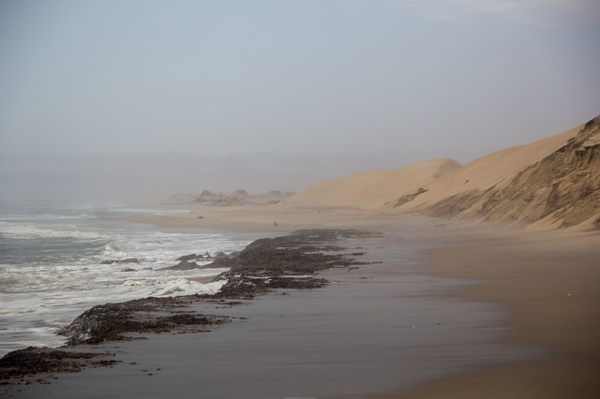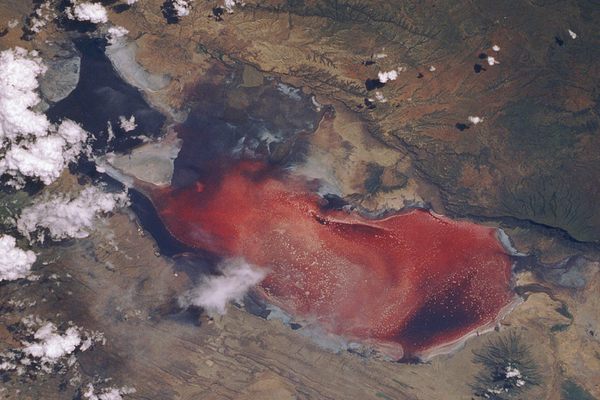Extraterrestrial Analogues: Seven Places That Really Are Like Being on the Moon and Mars
Apollo 16 preparing for the Moon on Earth (via NASA)
Before traveling millions of miles away to Mars, it might be good to test out whatever vehicles or other equipment you plan to use there. But how to do that when you’re still here here on Earth? It turns out that our planet holds quite a few terrains that are very similar to what you might find on the Moon or Mars.
Last month, the European Space Agency released a guide to these places. Called The Catalogue of Planetary Analogues, it includes everything from impact craters to tundra to deserts to volcanic areas, taking into account microbial habitats along with the land formations. Below are seven of these landscapes on Earth that really are as alien as outer space.
BLOOD FALLS
Antarctic Dry Valleys
via United States Antarctic Program
Blood Falls in the Antarctic Dry Valleys looks pretty freaky with its flow of red oozing from the ice, and according to the Catalogue of Planetary Analogues it’s ”considered to be the most ‘Mars-like’ environment on Earth.” This is both in relation to the Mars in the present and the Mars in the past, which makes it ideal for testing human mission scenarios. Apparently back in Martian history, the Red Planet also had its share of similar sub-glacial habitats, which make the Blood Falls analogous to some “relic” Martian sites.
photograph by Mike Martoccia
photograph by Mike Martoccia
ATACAMA DESERT
Northern Chile and Southern Peru
photograph by Tom Goskar
The plains of the Atacama Desert in Northern Chile and Southern Peru are almost void of life, much like we believe the Moon and Mars to be. This is due to the incredibly Mars-like arid soils that only allow the most limited of bacteria to survive.
photograph by Philip Morton
photograph by Lisa Germany/ESO
CINDER LAKE CRATER FIELD
Flagstaff, Arizona, United States
A simulated lunar mission at Cinder Lake (via Cline Library Special Collections and Archives, Northern Arizona University)
The Cinder Lake Crater Field is a bit different from other landscapes on this list, as it was manmade. Back in the 1960s, needing a place to test out equipment for the Apollo missions, the United States Geological Survey’s Astrogeology branch made a crater field that mimicked one based on a Lunar Orbiter image, making the perfect Moon analogue.
Testing space suits at Cinder Lake (photograph by Jake Maule)
Apollo 15 driving practice (via arizona.edu)
ASKJA
Dyngjufjöll Mountains, Iceland
photograph by Cristiano Corsini
The Askja stratovolcano in Iceland looks otherworldly with its ethereal blue water and reddish soil formed in an end-of-Ice Age eruption. All of the country is in fact a favorite for studying in preparation for Mars and the Moon as it has so many strange, often volcanic, terrains. Askja in particular was used as a training site for the Apollo missions.
photograph by eirasi/Flickr user
photograph by Andy Hares
MOUNT ETNA
Belpasso, Italy
via NASA
Mount Etna, unlike Askja, has never really stopped erupting. The Sicily stratovolcano is very much active, with altering volcanic topographies that make it a great place to do scientific and robotic studies for both Moon and Mars missions. Scientists even use Mount Etna as analogous to the volcanic activity of Venus, although our human space missions have yet to get so ambitious for that journey.
via UCL Mathematical and Physical Sciences
photograph by Tim Bekaert
NAMIB DESERT
Namibia, Africa
via NASA
What little life exists in the Namib Desert has to live off the moisture from the fog, although the oldest desert in the world does roll right up to the ocean. The massive desert also includes huge dunes, some reaching 300 meters (984 feet), high, which is the closest we have on Earth to the size of the dunes on Mars.
photograph by Pierre Lasage
photograph by Santiago Medem
PAVILION LAKE
Marble Canyon, British Columbia, Canada
photograph by SpacePhotoBill
You might not be able to tell by looking at its surface, but beneath Pavilion Lake in British Columbia are stone formations similar to ancient stromatolite fossils that are present on the Moon and Mars. Having these incredible “microbialites,” the lake attracts many scientific researchers interested in extraterrestrial geology.
photograph by SpacePhotoBill
NASA astronaut Rich Arnold in Pavilion Lake (photograph by SpacePhotoBill)
Click here to view all of “The Catalogue of Planetary Analogues,” and find your own alien landscape on our planet.
















Follow us on Twitter to get the latest on the world's hidden wonders.
Like us on Facebook to get the latest on the world's hidden wonders.
Follow us on Twitter Like us on Facebook